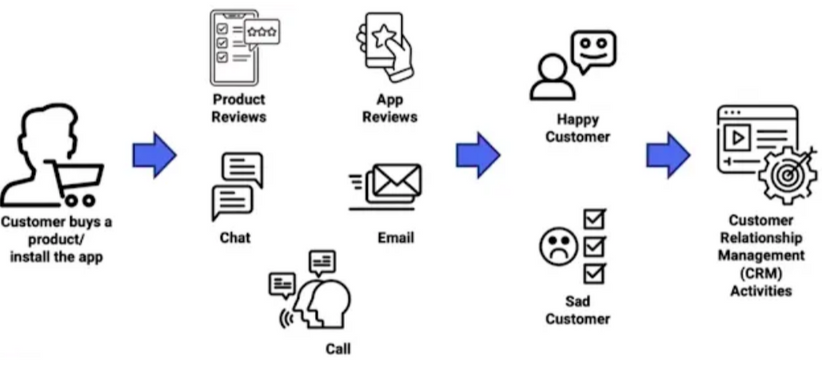Semantic analysis and AI, valuable to email channel and customer
Published on May 16, 2024 - Updated on May 31, 2024
Semantic analysis and AI, valuable to email channel and customer
Semantic analysis for email stands infamous. In today's digital landscape, email remains a crucial communication channel for businesses, encouraging personalized connections, disseminating information, and driving conversions. However, capturing attention and engaging recipients in a crowded inbox is increasingly challenging. Inboxes easily get overflown by an abundant amount of emails, making it very difficult if not impossible to properly analyze the customer experience.This is where semantic analysis emerges as a turning point in the customer experience.
By analyzing the emotional tone of email content and recipient responses, businesses can uncover valuable insights. These insights allow for the creation of compelling, emotionally resonant messages that significantly enhance customer engagement and loyalty. Imagine equipping your inbox with the ability to see beyond words, understanding the true sentiment behind a customer’s inquiry, a colleague’s feedback, or even your own unspoken feelings. Sentiment analysis, powered by advanced artificial intelligence, helps achieve this by decoding hidden emotions. This technological advancement not only boosts engagement but also transforms the way businesses interact with their customers, making every email a meaningful insight to your customers journey.
Embark with us to further explore the world of emotional analysis to convert an exhaustive list of emails into valuable insights.
I. What is semantic analysis ?
Semantic analysis explores the underlying, often hidden emotion felt by a client during his customer journey. Powered by Natural Language Processing (NLP), It classifies written words as positive, negative, or neutral, revealing the sentiment expressed by the author but can also reveal the unrevealed six primary emotions experienced.
In a previous blog, Qemotion highlights the benefit of automatic semantic verbatim analysis. I would highly recommend inviting you to gain further insight through that blog on our website: Comparison: Semantic analysis of verbatim manual or automatic?
II. How can semantic analysis be of value to emailing ?
One of the main issues for companies concerning customer feedback and employee satisfaction is the excessive number of the previous. As aforementioned, automatic semantic analysis answers these problems effectively and can be of valuable use for emails.

Indeed, there are various forms of customer satisfaction feedback and reviews . Email as opposed to other forms of feedback are often longer and more oriented. They can very much vary from one another and usually follow no specific guidelines. Consequently, they can be hard to analyze and time consuming. This is when semantic analysis can be useful in different ways:
a. Direct automatic response
Firstly, the use of generative AI can regroup and identify frequently asked questions. Semantic analysis can detect a particular subject and can answer these questions automatically. With a personalized prompt response, low added value emails are answered quickly and efficiently, leaving other requests that require a more expertised touch to the correct advisor.
With that in mind, the first step to analyze an email is to understand its intent. Semantic analysis can detect the subject and suggest to the client an answer. If the client is satisfied with the AI’s answer, he will most likely be satisfied with the swiftness of the reply, if not, the client can choose to address the query to an advisor.

Here is an example of the aforementioned. In this situation, the client has sent an email asking for help as to how he can adjust his withdrawal limit. Originally, an advisor would have to personally assist the client making the client wait. The use of semantic analysis and AI prompt response allows the client to receive an immediate response. On the off chance that the client is not content with the generated answer, he can transfer his request to an advisor.
b. Save time and improve efficiency
Semantic analysis significantly boosts efficiency by automating the categorization and prioritization of emails based on their emotional tone and urgency. This process saves valuable time for customer service teams, enabling them to focus on more complex issues that require human intervention.
Furthermore, semantic analysis supports strategic and targeted advisory orientation. AI can identify and classify specific subjects, ensuring that requests are directed to the most qualified advisor. This targeted approach not only enhances service quality but also ensures that customers receive the most relevant and expert assistance.
c. Ensure constant and high enhanced quality
Semantic analysis ensures that responses are consistent and of high quality. By understanding the context and sentiment, it helps in crafting more personalized and relevant replies, improving overall customer satisfaction.
Consistency in communication is vital for building trust and reliability. Semantic analysis helps ensure that all responses are consistent with the company’s communication guidelines and policies. By standardizing the tone, language, and structure of replies, businesses can maintain a cohesive brand voice across all customer interactions. This consistency reassures customers that they are receiving accurate and reliable information, regardless of whom they interact with within the company.
Semantic analysis not only helps in crafting high-quality responses but also facilitates continuous improvement. By analyzing customer feedback and the effectiveness of responses, businesses can identify areas for enhancement. For instance, if semantic analysis reveals that certain replies consistently receive positive feedback, these can be used as templates for future responses. Conversely, if certain issues or sentiments are frequently misinterpreted, the system can be adjusted to improve accuracy. This iterative process ensures that the quality of customer communication continuously improves over time.
d. Phenomenon detection
Semantic analysis provides the capability to continuously monitor and analyze the content of incoming emails. This constant scrutiny helps in identifying patterns and trends that may not be immediately apparent. For instance, a sudden surge in emails mentioning issues with a particular product feature could indicate a systemic problem that needs attention. By recognizing these patterns early, businesses can take proactive measures to address them, preventing minor issues from escalating into major customer satisfaction problems.
One of the most significant advantages of semantic analysis is its ability to spot emerging trends. By examining the language, sentiment, and context of emails, businesses can detect shifts in customer preferences, emerging needs, or new market opportunities. For example, if a growing number of emails express interest in a new type of service or feature, this trend can be identified and acted upon. Early detection of such trends allows businesses to stay ahead of the curve, innovate proactively, and meet customer demands more effectively.
By leveraging semantic analysis for phenomenon detection, businesses can significantly enhance their service quality. Here’s how:
1. Proactive Problem Resolution: By identifying issues early, companies can resolve them before they become widespread, thus maintaining high service standards and customer satisfaction.
2. Data-Driven Decisions: The insights gained from semantic analysis inform strategic decisions, enabling businesses to allocate resources effectively, prioritize high-impact areas, and implement changes that drive positive outcomes.
3. Improved Communication: Understanding common customer sentiments and issues allows businesses to craft more relevant and empathetic communication, addressing concerns preemptively in their messaging and support materials.
4. Customer Retention: By addressing pain points and emerging needs promptly, businesses can foster loyalty and reduce churn, ensuring a more stable and satisfied customer base.
III. How Q°emotion can assist your needs to alleviate customer pains with semantic analysis
Today Qemotion already leverages AI and semantic analysis on email through all kinds of sectors.
For instance, semantic analysis is helping assurance companies with direct answers for customers and suggested answers for advisors. Each time a customer creates a new conversation and wants to send it, semantic analysis scans it first and suggests an FAQ answer or a self-service option if possible. By doing this, the companies hope to decrease the quantity of emails it receives and handle these issues more effectively. Emails with similar intentions are grouped together by Q°emotion, which also reveals consumer pain points and prioritizes them.
Advisors' email responses may be made more timely and of higher quality by utilizing generative AI and semantic analysis. Furthermore, since advisors are no longer required to manage a significant portion of the inquiries, they enable them to concentrate on value-added interactions between a business and its clients.
Businesses may gain a deeper knowledge of their consumers' emotions and customize email communication by utilizing sentiment analysis. This increases engagement, creates more individualized connections, and eventually increases loyalty and success. Email sentiment analysis will become increasingly more important in creating emotionally charged email experiences as technology develops, reaffirming its place as a vital component of every effective email marketing campaign.